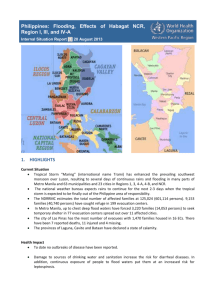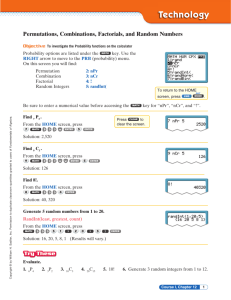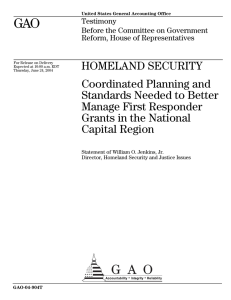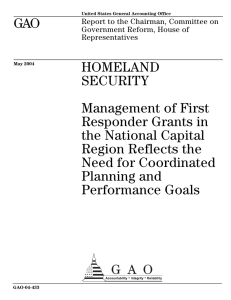“FEMA Preparedness in 2007 and Beyond” Darrell Darnell
advertisement
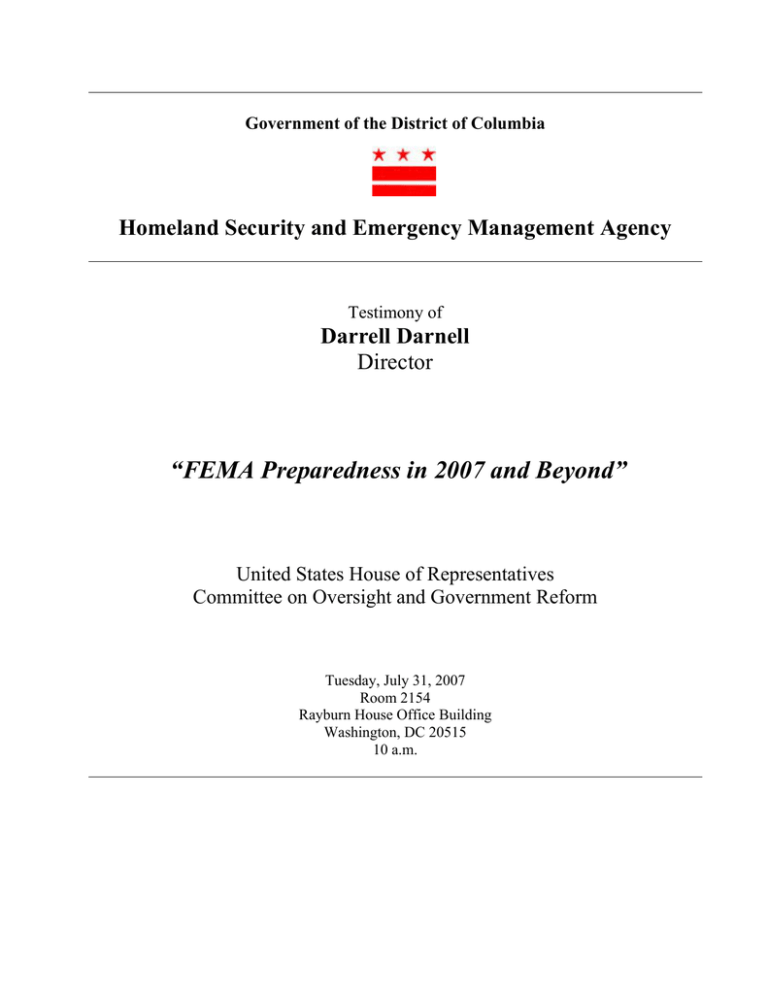
Government of the District of Columbia Homeland Security and Emergency Management Agency Testimony of Darrell Darnell Director “FEMA Preparedness in 2007 and Beyond” United States House of Representatives Committee on Oversight and Government Reform Tuesday, July 31, 2007 Room 2154 Rayburn House Office Building Washington, DC 20515 10 a.m. 1 Good morning, Chairman Waxman, Chairman Kucinich, Congressman Davis, Congressman Issa, and members of the subcommittee. Good morning also to my fellow panelists and other distinguished colleagues. I am Darrell L. Darnell, director of the District of Columbia Homeland Security and Emergency Management Agency (HSEMA). I am pleased to have the opportunity to testify before you today about the extent to which the District of Columbia is prepared to respond to emergencies and disasters, including our collaboration with our partners in the National Capital Region (NCR). The Committee’s letter of invitation identified five areas of preparedness the Committee seeks to examine – housing, transportation, medical assistance, security and logistics. I will begin my testimony by addressing the efforts by the District in coordination with its partners in the NCR to ensure competency in each area as it pertains to local priorities. During the almost six years since the terrorist attacks of September 11, 2001, and the two years since the Gulf Coast’s devastation from Hurricane Katrina, the District and the NCR as a whole have worked independently and in collaboration with our partners at the federal, state and local levels to enhance and improve our abilities in each of these five critical areas. Building on the foundation of planning, training, and exercises we established following September 11, we have incorporated lessons learned from Hurricane Katrina to develop an even more robust capacity to manage the consequences of natural disasters and other types of emergencies. As you know, following September 11 we developed local and regional response plans based on the National Response Plan, with common terminology and parallel structures and functions. We also are working to create or refine specialized plans and procedures in a variety of areas, including housing, sheltering and transportation (including evacuation,) as well as medical assistance, security and logistics. Transportation and Housing Evacuating the District is a daunting challenge under any circumstance. With traffic congestion a consistent problem, moving a significant number of people at once within the District and the greater region poses considerable difficulties. Moreover, a significant portion of the population relies exclusively on public transportation, necessitating government assistance during an evacuation effort. Acknowledging these difficulties, and having learned lessons from the Gulf Coast’s experience with Hurricane Katrina, the District has conducted regular evacuation drills (Operation Fast Forward) in conjunction with the July 4th festivities on the National Mall and is leading the NCR’s effort to coordinate evacuation and sheltering plans. A successful evacuation requires two crucial transportation efforts: quick, informed decisions about how to re-route traffic out of the affected area and a concerted effort to assist the part of the population that relies exclusively on public transportation. As we learned in Hurricane Katrina, the plans to do so must be established—and practiced—before an event occurs. An example of that practicing took place on July 4th. The District’s Department of Transportation (DDOT), in coordination with its regional transportation and public safety partners, 2 and in coordination with its July 4th traffic control plan, carried out a limited test of its emergency traffic signal timing patterns and emergency traffic operations capabilities. The test, known as Operation Fast Forward III, incorporated the lessons learned in the previous two tests and continued a review of emergency plans and operations . DDOT is currently evaluating regional traffic signal timing, emergency route traffic control, and is testing emergency transportation communication protocols. Understanding that any evacuation undertaken in the District will quickly involve our regional partners, we have worked closely with them to develop a number of tools that would assist decision-makers in all of the jurisdictions during an emergency. These resources include a regional, unified evacuation route profile; an inventory of vehicles, drivers, transfer/pickup points and standing agreements that could be activated across the region in the event of an emergency. The transportation inventory catalogs the availability, type, and number of vehicles that could meet emergency requirements, while the evacuation route profile includes: • Functional classification in the regional roadway system • Route length • Roadway dimensions and variability • Route capacity • Route constraints • Average weekday and peak period travel demand • Route signal control plans Once District residents and visitors have been evacuated, the focus turns to sheltering. The District has been working closely with the American Red Cross to inventory shelters within the city. Further, as part of the ongoing regional evacuation effort, we are conducting an assessment of shelter facilities throughout the National Capital Region and developing profiles for large capacity (>5,000) shelters. As we know, providing this information to those who will make decisions during a disaster and, importantly, familiarizing them with it before an event occurs is crucial to a successful evacuation. These tools, coupled with our existing District-specific plans, put us in a much better position to conduct a mass evacuation than we would have been prior to Hurricane Katrina. Medical Assistance The ability to respond to the health and medical consequences of a large scale incident requires a combination of plans, facilities, properly trained clinical staff, pharmaceuticals, equipment, and supplies; interpreted as “medical surge” capacity. The District, in coordination with the region, has steadily increased bed capacity and has added 300 hospital beds within the District’s borders. Medical surge preparedness efforts within the District have switched from concentrating on simply increasing bed capacity to the need to develop full capabilities. As an example, if a hospital simply bought more beds, equipment, and supplies, the investment would not necessarily save more lives if the hospital did not also have enough clinical personnel with the training required to care for the patient, particularly for patients that require unusual or highly specialized care. Training seminars in the National Incident Management System (NIMS) and Hospital Incident Command System have been offered to local health officials to insure a further understanding of the command and control structure of an incident. In April 2006 the District convened a Pandemic 3 Influenza summit, which brought together federal and District officials along with business and community leaders, members of the health care community and a broad spectrum of other stakeholders to discuss the city’s preparations for a possible influenza pandemic. Subsequently, in October 2006 the Region funded a pandemic flu exercise focusing on health and medical response. Avian / Pandemic Influenza preparedness training and education for the community have been offered and 550 persons in the NCR have been educated about disease transmission, specific infection control plans and protocols, and have participated in discussions about ways to limit the spread of disease. Additionally, a “Train the Trainer” course on how to prepare their employees for a pandemic has been offered to NCR occupational health nurses. Public information officers in the District and the region also have received crisis communications training related to pandemic influenza. The majority of funding for medical surge resulting from a mass casualty event has paid for developing “response” capabilities. To assist in preventing the spread of a biological agent, the District’s health community has been provided with a syndromic surveillance system. This system builds a potential “prevention” capability or early warning system that permits the public health community to receive early warning of an impending health situation and take proactive measures to stop a potential public health emergency. This system connects pharmacists, hospital emergency rooms, schools, veterinarians, laboratories and emergency medical services information and spots trends within the data to begin to track an outbreak and assist in identifying the potential spread. Security and Law Enforcement As the Nation’s Capital, The District of Columbia presents a unique environment for security and law enforcement. The District is home to numerous law enforcement agencies (more per capita than anywhere else in the country), including the D.C. Metropolitan Police Department, the United States Capitol Police, the Secret Service and the F.B.I., among others. These agencies work together in a collaborative fashion on a daily basis to provide security to the citizens of the District as well as federal government agencies and employees. Frequent large scale special events in the District require well-coordinated inter-agency operations, and keep the various law enforcement agencies in the area well-practiced in working together. Events such as presidential inaugurations, state funerals, the National 4th of July celebration and other federal special events require a joint effort by MPD, FBI, Secret Service, U.S. Capitol Police and others. In fact, we are already setting up an inter-agency working group to begin the planning process for the next presidential inauguration, even though it is a year and a half away. A cornerstone of this coordinated security and law enforcement capability is the transparent sharing of intelligence information between federal and local partners. In the District, in 2006, we took the next step towards improving this already robust sharing of information by establishing the Metropolitan Washington Fusion Center. The center, which currently shares resources with the FBI, is working towards standing up a fully functional fusion center which will provide a mechanism for law enforcement, public safety and private partners to come together with a common purpose and improve the ability to safeguard our homeland and prevent criminal activity. By routinely analyzing disparate pieces of information, the fusion center is a major contributor to enhancing situational awareness and achieving a common operating picture. Integral to the success of the District’s fusion center is close, regular collaboration with existing fusion centers in our partner jurisdictions in the National Capital Region as well as with DHS’s National Operations Center. 4 Logistics In addition to the accomplishments noted in transportation and housing, our efforts in the area of interoperable communications – a primary focus for the region – have yielded significant improvements in our ability to share information and communicate across jurisdictional boundaries. In an assessment conducted by DHS, the National Capital Region ranked in the top 10% of urban areas in the nation for advanced interoperable communication. In furtherance of the goal of interoperable regional communications, the D.C. Homeland Security and Emergency Management Agency established a regional emergency operations center committee in August 2006 with representation from more than 140 federal, local and regional EOCs. The group’s members were linked through the Washington Metropolitan Area Warning System (WAWAS), whose control point is the D.C. HSEMA. In April 2007, the Council of Governments Emergency Managers Committee incorporated the EOC committee into a newly-established subcommittee known as the NCR Operations Center Coordination Group. Current membership includes DHS and the Department of Defense’s U.S. Army Military District of Washington/Commander, Joint Force Headquarters-National Capital Region., as well as NCR jurisdictions. Through this standing body, the practitioners at the state, local and federal levels regularly seek ways to enhance information sharing and collaboration. Since the technological impediments to information sharing have largely been conquered, this body has turned its attention to establishing agreements between Emergency Operations Centers (EOCs) in order to ensure standard operating procedures. The District also has installed WebEOC, a web-based crisis management system that allows emergency managers and first responders to track an emergency event in a common operating picture. All of the NCR jurisdictions, as well as several dozen federal partners—including DHS’s FEMA, the U.S. Secret Service, and the Coast Guard—have joined the network and are able to quickly and easily share real-time information. WebEOC users have the option to post information relevant to the region to a common page that participant EOCs can see. This system is the primary vehicle for sharing information and achieving situational awareness in the National Capital Region on a daily basis. While WebEOC is used throughout the region for day-to-day operations, it also can provide a specific forum for collaboration during a major event. Specific agencies and jurisdictions are granted access to a customized site where event-specific information is exchanged among those with a need to know, enhancing capability while protecting sensitive information. Other communications initiatives include the District’s four-part citizen emergency notification system, which includes voice alert, text alert, the Emergency Information Center website and the Emergency Alert System, the partnership between government and the broadcast industry that allows regular programming to be interrupted to broadcast emergency information. The text alert system has been made available to all NCR jurisdictions and residents are able to enroll in systems across the region, not just where they live. It also has been expanded to include special groups such as safety and security officers at member institutions of the Metropolitan Washington Consortium of Colleges and Universities and discussion are on-going to establish a group for Federal Protective Service officers located at buildings that have joint federal and commercial tenants. The region also has purchased a cache of 800 Mhz radios that can be used for regional events and has installed repeaters in Metro tunnels to help ensure uninterrupted communications ability. 5 Collaboration with the Office of National Capitol Region Coordination Since its establishment in March 2003, as part of the Homeland Security Act of 2002, the Office of National Capital Region Coordination (ONCRC) has worked closely with the jurisdictions in the NCR to help ensure regional cooperation and coordination. As early as August 2002, when the governors of Maryland and Virginia, the Mayor of the District of Columbia and Governor Tom Ridge, director of what was then known as the White House Office of Homeland Security, convened a regional summit and committed to eight action items, it has been widely acknowledged that the NCR occupies a unique position among the nation’s states and cities and, therefore, requires a level of regional coordination above what may be required in other localities. ONCRC has coordinated with the District of Columbia and regional partners to develop a strategic plan that guides decision-making on homeland security priorities. The strategic plan demonstrates the ability to work together to leverage the best of local strengths with the ability to execute across local and state jurisdictional lines to share information, synthesize data, prioritize transportation flows, track health and infectious disease movement, and mitigate all-hazards risks affecting the region. One final comment, regarding the restructuring of the federal response structure to include a PFO in addition to the FCO. As a state emergency management director, it is my opinion that adding additional federal officials to the process may lead to confusion about the roles and responsibilities of each. It would be helpful to have only one federal official assigned for all events, versus multiple federal officials for different incidents. Clarification of the role and responsibility of that official would also improve the process. With the leadership of Chris Geldart, I believe ONCRC will continue to work with its partners to ensure further progress in preparing and securing the NCR against disaster, whether natural or manmade, in the coming years and we look forward to our continued success. This concludes my prepared testimony. Thank you for the opportunity to appear before you today. I am prepared to respond to any questions you may have.
